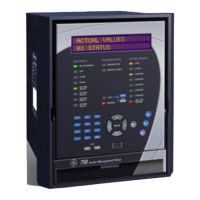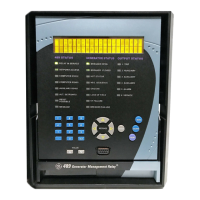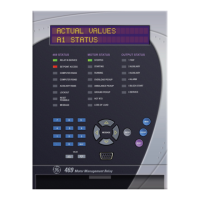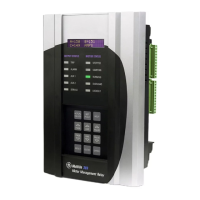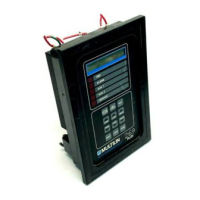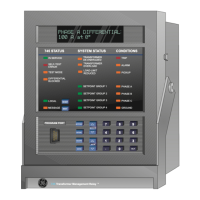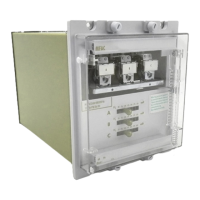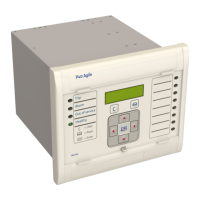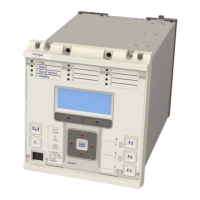Metering
745
Transformer Management Relay
Commissioning
http://www.GEindustrial.com/multilin
7–9
GE Multilin
The above results can be verified with two adjustable sources of three-phase
current. With a single current source, how the relay performs the necessary phase
angle corrections must be taken into account. Table 5–1: Transformer Types on page
5–11 shows that the Y-side currents are shifted by 30° to match the Delta
secondary side. The 30° phase shift is obtained from the equations below:
(EQ 7.7)
By injecting a current into Phase A of Winding 1 and Phase A of Winding 2 only, I
W1b
= I
W1c
= 0 A. Therefore, if we assume an injected current of 1 × CT, the transformed
Y-side currents will be:
(EQ 7.8)
For the purposes of the differential elements only, the transformation has reduced
the current to 0.57 times its original value into Phase A, and created an apparent
current into Phase B, for the described injection condition. If a 1 × CT is now injected
into Winding 1 Phase A, the following values for the differential currents for all three
phases should be obtained:
Phase A differential: 0.57 × CT ∠0° Lag
Phase B differential: 0.57 × CT ∠180° Lag
Phase C: 0 × CT.
c) Effects of Zero-Sequence Compensation Removal
The transformation used to obtain the 30° phase shift on the Y-side
automatically removes the zero-sequence current from those signals. The
745 always removes the zero-sequence current from the delta winding
currents.
If the zero-sequence component is removed from the Delta-side winding currents,
the Winding 2 current values will change under unbalanced conditions. Consider the
case described above, with the 1 × CT injected into Phase A of Winding 2.
For the 1 × CT current, the zero-sequence value is 1/3 of 1.0 × CT or 0.333 × CT A.
The value for I
W2a'
is therefore (1.0 – 0.333) × CT = 0.6667 × CT A. This value must
be divided by the CT error correction factor of 0.797 as described above.
Therefore, the value of differential current for Phase A, when injecting 1 × CT in
Winding 2 only, is:
(EQ 7.9)
The action of removing the zero-sequence current results in a current equal to the
zero-sequence value introduced into phases B and C. Hence, the differential current
for these two elements is:
(EQ 7.10)
Now, applying 1 × CT into Winding 1 Phase A and the same current into Phase A
Winding 2, but 180° out-of- phase to properly represent CT connections, the total
differential current in the Phase A element will be (0.57 – 0.84) × CT = –0.26 × CT.
The injection of currents into Phase A of Windings 1 and 2 in this manner introduces
a differential current of (–0.57 × CT + 0.42 × CT) = –0.15 × CT into Phase B and (0.0
× CT + 0.42 × CT) = 0.42 × CT into Phase C.
Ambient Temperature
Input
a) Basic Calibration of RTD Input
1. Enable ambient temperature sensing with the
S2 SYSTEM SETUP !" AMBIENT TEMP
! AMBIENT TEMPERATURE SENSING setpoint.
2. Connect a thermocouple to the relay terminals B10, B11, and B12 and read
through the
A2 METERING !" AMBIENT TEMP ! AMBIENT TEMPERATURE actual value.
I
W1a′
I
W1a
I
W1c
–
3
--------------------------------
, I
W1b′
I
W1b
I
W1a
–
3
---------------------------------
, I
W1c′
I
W1c
I
W1b
–
3
-------------------------------- -===
I
W1a′
1CT×
3
----------------- -
, I
W1b′
1CT×–
3
-------------------- -
, I
W1c′
0CT×
3
----------------- -== =
NOTE
I
A differential()
0.667 CT A×
0.797
------------------------------------- 0.84 CT A×==
I
B differential()
I
C differential()
0.333 CT A×
0.797
------------------------------------- 0.84 CT A×===
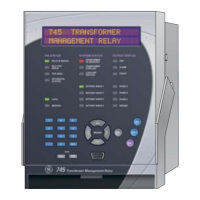
